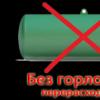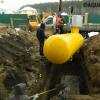Specialization: decoration of facades, interior decoration, construction of cottages, garages. The experience of an amateur gardener and gardener. There is also experience in car and motorcycle repair. Hobbies: playing a guitar and much more, which is not enough time :)
The question of connecting pipes without welding is always relevant, since not every home master has a welding machine, and not everyone knows how to use it. At the same time, not a single pipeline is eternal, so such a need may arise in the country, in a private house or apartment at any time. Below I will share with you some secrets of specialists who allow you to make such connections without welding.
Metal
First of all, it should be said that all existing pipes can be conditionally divided into two types:
- metal;
- plastic.
As a rule, the most problems arise with docking metal pipes, so first we’ll look at how to connect them.
So, there are several options for tight docking:

Below we will familiarize ourselves with each of these options in more detail.
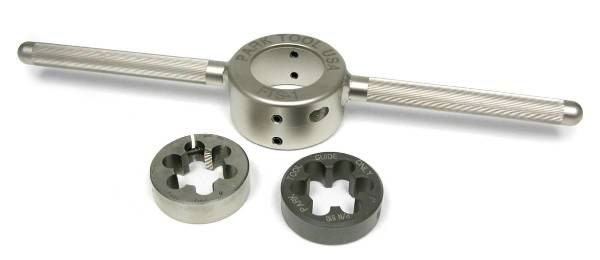
With threaded sleeve
Most often, metal pipes without welding can be joined using threaded connection. In this case, respectively, threading is required. It should be noted that this is not such a complicated procedure as many might think at first glance.
For threading you will need an electric thread cutter or dies to manually perform this operation. Since the price of an electric tool is very high, below I will tell you how to do the work manually:
- first of all, you need to clean the paint surface, which is subject to threading. If there are influxes of metal on it, for example, remaining after welding, they must be grinded off;
- then you need to remove the external chamfer from the end using a file;
- then on the prepared end of the part you need to put on a lehr (die) and make half a turn. In this case, it is necessary to ensure that the die is put on strictly perpendicular to the axis;
- then you need to perform a quarter turn back;
- according to this principle, the thread is cut to the required length. In the process of cutting, the cutters must be lubricated with a special fluid or any other lubricant;
- then, according to the same scheme, threading is carried out on another connected pipe part.
For sleeve mounting on one pipe, the length of the thread should be several times longer than on the other so that the sleeve with nut can be screwed onto it.
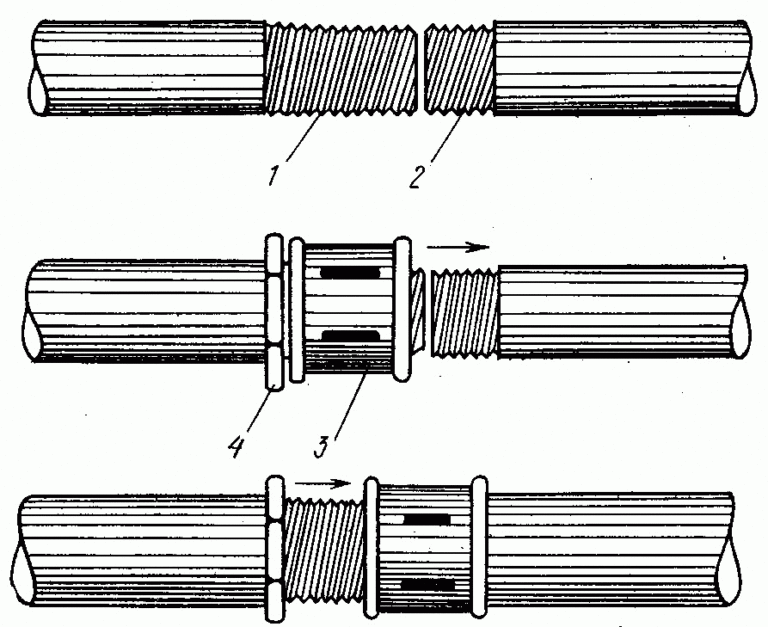
After threading, you can make a sleeve joint with your own hands, which is performed as follows:
- a nut is screwed onto a long thread and then a coupling;
- a nut is screwed onto the second end of the part;
- then the pipes are connected, and the sleeve is folded with the length of the thread, as a result of which it begins to wind on the second part with a short thread. This procedure must be performed until the junction is approximately in the middle of the coupling;
- then nuts are screwed on both sides. Before tightening them, wrap the tow plug between the couplings and nuts to waterproof the joint.
This connection is reliable and durable. However, it is far from always possible to thread. If, for example, the pipeline is located close to the wall, this operation is unlikely to succeed.

Gebo coupling
The Gebo coupling ("gebu" or "gebra") is a special compression fitting. With it, you can connect steel pipes without threading and welding very quickly, and for this you do not need any special tools.
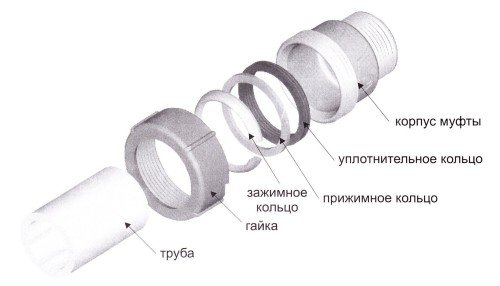
The scheme of its use is extremely simple:
- details are put on the pipe in the following sequence:
- nut;
- clamping ring;
- pressure ring;
- sealing ring;
- coupling;
- then put on the coupling halfway and tighten the nut;
- further, the second part is connected to the fitting in the same sequence.
I must say that this fitting exists both in the form of a coupling, and in the form of a tee. This allows you to use it in cases where you need to perform an insert, for example, in a riser to perform wiring.
As for reliability, it depends on the quality of installation. If the work is done correctly, then this installation is reliable and durable.

You can also connect pipes without welding and threading using a repair and mounting clip. This fitting is a sleeve or tee, which consists of two parts. Both halves are pulled together by bolts.
It should be noted that the repair and mounting clips are intended primarily for temporary repairs, for example, in the event of cracks. However, in emergency situations, they can also be used for pipe joining, especially if the pipeline does not work under high pressure.
In this case, the installation instructions are as follows:
- first of all, the parts of the pipeline parts on which the fitting will be worn must be cleaned of rust and all kinds of irregularities so that their outer surface is absolutely smooth;
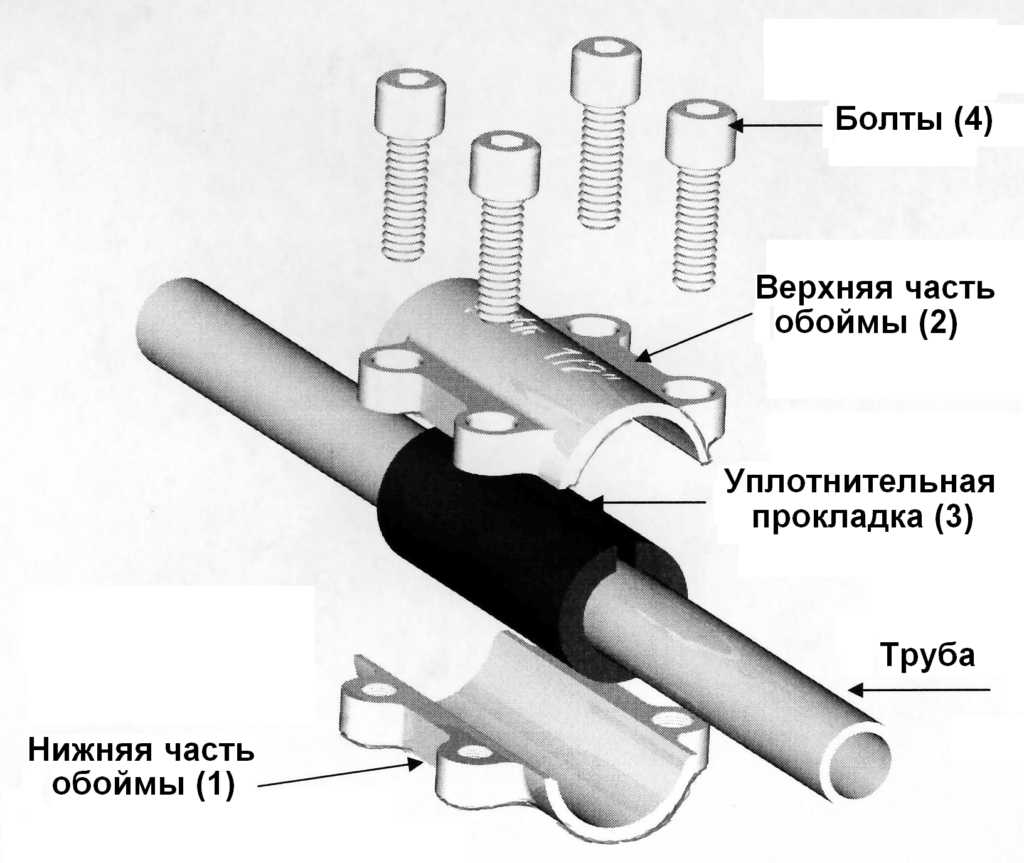
- then put a rubber seal on the pipe. Seal the seal section with silicone sealant. It should be noted that the seal must completely cover the pipes so that there is no gap.
- then both halves of the fitting are put on a rubber seal and tightened with bolts, as shown in the diagram.
This method, as we see, is also extremely simple. According to the same principle, the connection is made with a clamp-coupling. The only difference is that it drags on one side, not two.
I must say that if you use pipe clamps, connecting pipes without welding is even more reliable than using a mounting and repair sleeve.
If you need to make a connection profile pipes without welding to assemble any structure, you can also use special profile clamps.
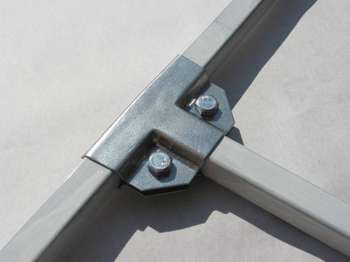
Plastic
If you need to assemble a plastic pipe, you can use compression fittings that work on the same principle as the Gebo coupling. Most often, metal-plastic and PVC pipes are connected in this way.
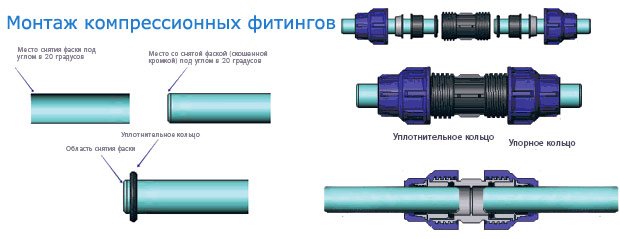
Also, sometimes special glue is used for these purposes. The installation process in this case is extremely simple:
- places are smeared with special glue;
- then the details are turned half a turn;
- in this position, they should be held until the glue hardens.
I must say that this connection is quite strong, since the adhesive dissolves adjacent surfaces, and, in fact, welds them.

Crimp fittings are also used to assemble metal-plastic pipelines. However, this requires a special tool that allows them to be pressed.
For temporary repairs, the clamps described above can also be used.
Here, perhaps, are all the most effective ways of joining pipes without welding, with which I wanted to acquaint you.
Conclusion
As we found out, in addition to welding, there are a number of other methods by which you can perform repairs or even installation of the pipeline. Moreover, some of them allow you to get no less reliable and durable connection. The only thing, in any case, the work must be done very carefully, in accordance with the above recommendations, so that the pipeline turns out to be airtight.
For more information, see the video in this article. If you have any difficulties in the process of connecting the pipes, ask questions in the comments, and I will definitely try to help you.
July 25, 2016If you want to express gratitude, add clarification or objection, ask the author something - add a comment or say thanks!
The most widely used are currently prefabricated (sectional) aluminum alloy radiators.Their reliability can vary greatly - this is primarily due to the design features of the product (as a rule, the thickness of the metal radiator and the quality of the aluminum alloy).
* For example, if radiators of various manufacturers are sold in a store (one of which gives a one-year warranty and at the same time indicates a service life of 15 years, and the other guarantees 10 years with a service life of 50 years), then it’s unlikely that even a person far from plumbing and heating equipment doubts arise which of these radiators is more reliable.
The price (with the same number of sections) can also be far from the same, but this is not the case when you should save.
* Relatively recently, the so-called "bimetal" radiators appeared on sale (aluminum alloy on the outside, and inside various sizes of inserts made of other metals, usually steel).
Demand for such products (initially reaching a very high level) is now falling. Probably because (as life has shown) the described advantages of such models have been greatly exaggerated. Of course, steel is a much stronger material than aluminum alloy. Moreover, its chemical resistance (with respect to the coolant) is also significantly higher.
However, in full measure, all this can manifest itself only with tightness steel "shirt", that is, the absolute absence of contact of the coolant with the aluminum alloy.
Production of radiator sections such construction is expensive, often the manufacturer is disingenuous - steel tubes are installed only in separate sections of the section.
And if at the same time there is no contact of metals at the molecular level, then the probability of coolant leakage always remains between them.
And here it will be more correct to consider that it is not water inside the steel tube but the tube in water.
In addition, direct contact in the common environment with the properties of the electrolyte of two different metals always leads to increased wear of the less resistant (of course, steel parts are in any aluminum radiator, such as futors, plugs, plugs, nipples ibut the less of them the always better).
Various coefficients of thermal expansion of steel and aluminum alloy will bring nothing but harm. And the heat transfer of such a radiator is reduced to some extent.
Among the high-quality radiators, we note the trademark "Nova Florida" (Italy), the company "Nova Florida" is the world's first manufacturer of sectional radiators made of aluminum alloy.
The declared service life is 50 years, the warranty is 10 (for some models - fifteen).
* There are big doubts that an aluminum radiator can last half a century on our heating networks, but the manufacturer of radiators is not responsible for the quality of the coolant.

 * When buying, also pay attention to the presence of factory defects and shipping damage (scratches, cracks, chips of enamel), - when inspecting the product, unpack it completely and remove the protective film.
* When buying, also pay attention to the presence of factory defects and shipping damage (scratches, cracks, chips of enamel), - when inspecting the product, unpack it completely and remove the protective film.
It will be useful to pay attention to some design features of the heating device. For example, the gaps between the sections on the back (back) side of the aluminum alloy radiators at first did not allow horizontal displacement of the product on the supporting hooks during installation (Fig. 1), and this greatly complicates the installation.
Currently, this moment has been taken into account by almost all manufacturers (Fig. 2), but nevertheless, the verification will not harm.
If the heater you need (by the number of sections) is not on sale and there is no time to look, you can assemble the “battery” yourself, from two (or more) radiators m esmaller size.
To assemble one radiator from two (or attach a section), you need two radiator n anda pepel, two intersectional laying and a radiator key.
Nipple i and gaskets (paronite or special cardboard) are sold in stores, the radiator key can be rented or made independently (to attach one section, any improvised tool will do, in principle - an adjustable wrench handle, a solid chisel of the required width, scrap steel strips s etc.).


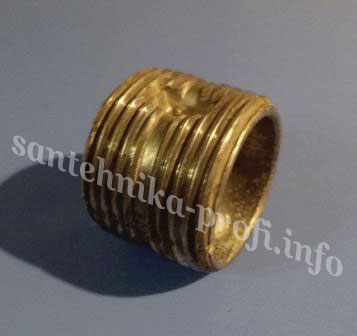
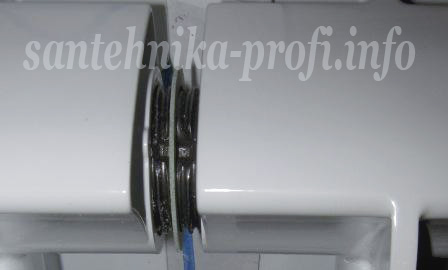
* Attention! Between the radiator sections should be installed only factory-made gaskets designed specifically for this purpose.
Installation between sections of gaskets FROM RADIATOR FITTINGS, or HOME (from plain cardboard or rubber) is UNACCEPTABLE!
Also keep in mind that it is recommended to build aluminum radiators only with the same type sections, and then almost certainly the connection points will be slightly different from the factory ones.
Build Order:
Both radiators (or radiator and section) are placed with the back side on a flat flat surface (if you do not have a special stand with clamps for rigidly fixing the workpiece, it is much more convenient and reliable to assemble it on the floor than on the table).Two nipples mounted on their middle part (without threads s) the gaskets are slightly screwed into the threaded outputs of one (b aboutmore) radiator to a minimum, only so as not to fall out.
* Do not reverse polarity!
Nipple on the other hand i slightly tightened by the attached section.
* Attention! No special preparation of the butt ends and the use of sealant is required.
At the same time, on the crimping planes of the sections (removed from another radiator), the remnants of the factory gasket, which must be carefully esay (without subsequent grinding) with a thin-blade construction knife.
Try on the radiator key to the desired depth (the middle part of the tip of the "blade" of the key goes to the middle of the nipple).
* The process requires repeatedly removing and rearranging the key for alternating screed of the upper and lower nipples.
You can try it again each time, or you can simply mark the boundary of the maximum depth (for example, using paper tape or tape, superimposed on the axis of the key at the desired point).
Do not forget that during the screeding process, the depth of insertion of the key gradually decreases.
* Strong advice of some "specialists" to assemble and disassemble the radiator only two keys (according to the principle of factory ties, in order to avoid distortion and damage to the product) should not be taken seriously. Such recommendations are usually given by people either just starting their activities in this area, or not having anything to do with it at all.
If the fitter is an installer one with a radiator key can easily and simply perform such work alone, then two keys will have to work at least two, or even three (two twist, and the third locksmith holds the radiator). There is no benefit from such an organization of the assembly order - they will only interfere with each other.
As for the possible damage to the heater with an alternate screed, then for the vast majority of standard radiators (subject to elementary apitchfork) it is practically impossible.
 The fact is that the thread of the nipple (ø 1 inch) is very large, and the design (as a rule) provides significant gaps between it and the internal thread of the section.
The fact is that the thread of the nipple (ø 1 inch) is very large, and the design (as a rule) provides significant gaps between it and the internal thread of the section.
And from this, in turn, the inevitability of "play" in the connection with the screed follows.
In other words, alternating twisting of each nipple by an average of one revolution in the vast majority of cases cannot lead to any dangerous loads.
Of course, until the last moment the key should be turned only by hand (without an additional tool) and only as long as the nipple "goes" completely free.
Only after alternately tightening the nipples "by hand" (until the sections are completely joined), is the final tightening performed using the lever, which is inserted into the eye of the key.
This is accomplished with a fairly significant (but not excessive) effort in two stages in turn on each nipple.
Preliminary pulling of nipples into "half-force", final - practically with the maximum effort that the average person is capable of (with a lever length of 20 - 25 cm from the key axis).
We remind you once again - you should stretch tight enough but do not overdo it. Theoretically, it is possible to break the thread of the radiator section and rupture of the nipple from excessive load (as a rule, this happens with an excessive length of the lever).
A case was noted when a locksmith managed to break even a radiator key.
Keep the radiator (with significant key loads) should be as close as possible to the attached section, from the side opposite to the direction of rotation.
* Attention! Our instructions regulate how to "build up" sections of standard aluminum and bimetal radiators. For the assembly and extension of sections of non-standard radiators (for example, some bronze models with a "fine" thread of nipples), the above procedure is not applicable in full.
In the near future, posting on the site instructions for assembling custom models is not planned.
Now about radiator fittings
(end caps - plugs and futorki with diameters of internal threads 1/2 or 3/4 inches).
Since radiators are assembled from separate sections by tightening them on nipples with an external thread ø 1 inch of different directions, the futorki and plugs (plugs) also differ in the direction of the external threads s.To your right (if you look at the front surface of the radiator), parts with the usual direction of threading that are familiar to us are installed s ("right"). On the left - on the contrary, only with a "left" thread.
* Diameter and pitch of external threads s radiator fitting fully complies with the sanitary standard (for ø 1 inch). Therefore, on the right, any plumbing connection to the outside can be screwed into the radiator if desired without an additional transition inch thread (plug, transition connection to a different diameter, steel pipe with threaded thread, threaded connection-transition to a plastic, metal-plastic, copper pipe, etc.). But on the left such a “trick” will no longer pass.
But there is a serious reason why this should not be done in any case - radiator fittings are designed to cushioning sealing, and threaded plumbing connection on winding.
Sealing the connection with any winding material implies a significant degree of compression between the internal and external threads.
This is certainly a risk factor for parts with internal threads (in this case, the radiator section), and the aluminum alloy is significantly inferior in strength to most other metals and their alloys used in plumbing.
If the material of the section is characterized by high ductility, then a similar "experiment" can end quite successfully. However, the aluminum alloy of the radiator sections of most manufacturers is very fragile, and a direct winding connection can lead to the appearance of a longitudinal crack (across the threads) during assembly or some time after it. And depressurization of the existing heating system is a very dangerous accident, often with extremely serious consequences.
When choosing radiator fittings, attention should be paid to the wall thickness of the threaded part and the perimeter of the connection of the hexagonal part of the fitting to the thread.
* Important! Keep in mind that a serious manufacturer of radiators, as a rule, produces and everything that is necessary for their installation (first of all, covers and plugs) is also of very high quality. But! They almost never come with the product (and rightly so, since the installation scheme can be very different and guessing the optimal configuration is unrealistic). Therefore, if your radiator is still sold complete with futors, corks, fasteners, keep in mind that this is almost certainly not an initiative of the manufacturer, but the supplier (and possibly the store) in order to get rid of slow-moving installation kits. At the same time, they can be released anywhere (it is possible that this can not even be determined).
On radiator futors and plugs of some excessively economical manufacturers, there were cases of a crack at the base of the thread (up to complete breaking) when installed on the radiator.
Also pay attention to the quality of the gasket. A truly reliable connection is provided by a gasket made of durable material (for example, dense rubber) deeply embedded (sometimes glued) into the groove of the crimping plane of the fitting.
If this condition is not met by the manufacturer, then the probability of damage to the gasket during tightening or squeezing it out of the crimp plane (in whole or in part) is very high.
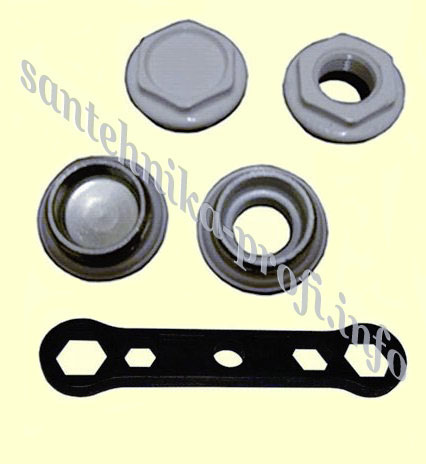 * By the way, radiator fittings under the brand name "Nova Florida" (see above) are produced of exceptionally high quality.
* By the way, radiator fittings under the brand name "Nova Florida" (see above) are produced of exceptionally high quality.
* Before installing the foot on the radiator, contact surface sections Lubricate with a special silicone sealant (non-acidic).
* Radiator fittings (corks and futorki) are usually available in pure steel, painted with white enamel. When tightening (and tightening must be tight enough), any metal tool will damage the enamel and black marks will remain on the corners of the faces, which should be painted over after installation.
You can also use a special tool (not damaging the coating), for example plastic key for radiator fittings. The main condition that must be observed when working with such a tool is tight tightening it to the fitting at the time of tightening. Otherwise, the plastic key will slide off under load and wear out to one degree or another, and after each “breakdown” the reliability of the subsequent fixation of the tool on the hexagonal part of the part will drop.
This system allows you to adjust the heat transfer your radiatorbut does not create problems for your neighbors.
 Its scheme is extremely simple.
Its scheme is extremely simple.
The radiator inlet and outlet pipes (upper and lower) are connected to each other by a jumper pipe (“bypass”) on the tees, and an adjustment valve is mounted between the lower tee and the heater (practice has shown that a regular ball valve from a reliable manufacturer works just as well).
One tap to adjust the heat transfer is enough, but it is better to install two (top and bottom). This will allow not bothering the neighbors (and locksmiths of the service organization) at any time to independently and completely turn off the coolant supply to the radiator (for example, in the event of an accident, planned replacement or washing of the device).
* IMPORTANT! One of the main operating rules for aluminum-based radiators is the inadmissibility of tight shut-off (i.e. shut-off valves at the inlet and outlet) of a filled radiator for a more or less significant period.
Upon contact of aluminum and water, a chemical reaction occurs with the release of free hydrogen. This process is confined. over time, it will inevitably lead to a critical increase in pressure and ultimately to an explosion.
Almost all manufacturers of aluminum radiators take this probability into account (which affects the design of the device), so most likely it will be a safe explosion. It is even possible that you will not notice it, but the radiator (at least one of the sections) will become unusable unambiguously.
If for any reason your battery has been disconnected both taps, then open the first one carefully (smoothly) to avoid water hammer (it is advisable to start from the bottom).
Often, with such a system, 3 valves are mounted (installing the third on the bypass tube) in order to be able to direct the entire heat carrier flow only through the radiator for maximum heat transfer).
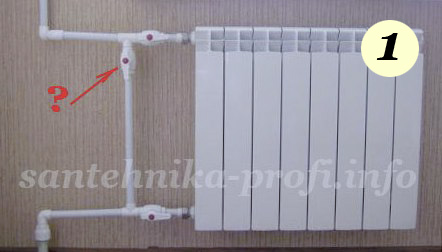
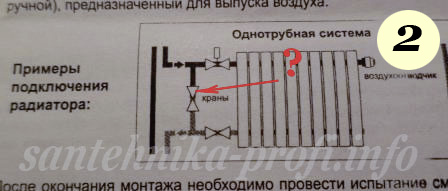 This is a serious violation, which can be compared with the theft of another's property. After all, closing the "bypass" you take to myself heat for which paid by your neighbors.
This is a serious violation, which can be compared with the theft of another's property. After all, closing the "bypass" you take to myself heat for which paid by your neighbors.
In addition, by accidentally closing another (any) tap, you will stop the circulation of the coolant throughout the riser. And this is not only administratively punishable and falls under a large fine, but can also lead to a serious accident (if part of the pipeline is in the freezing zone, for example, it goes into the attic of a building).
Even if a similar connection diagram is indicated in the device passport (see Photo-2), then this (in any case, when connecting the radiator to the heating system tenement house) wrong.
If you install a heater in your personal cottage, which is also heated by your personal "local" heating system, this your own business (although in this case the single-pipe connection scheme is ineffective and rarely used).
And here is the tenant’s intervention in setting up the overall heat distribution should be ruled out!
Now look carefully at photo No. 1.
If you do not take into account the tap on the bypass, then the rest of the radiator is mounted without any violations. And most importantly, a uniform slope is maintained with a rise to the upper pipe.
At first glance it seems that the bias could be made smaller, but in this case it is not. Steel pipes come from above and below (from the neighbors), which when supplied with heat (as a rule) are lengthened by heating by several millimeters each. And if during installation to bring the slope to a minimum, then after starting the system, it may well become the opposite.
It is also important to provide for the presence of these very horizontal sections of pipes, at least 30 cm (between the riser and the bypass) to compensate for thermal expansion. If pipes between the riser and the bypass jumper to aboutmouths, or they don’t exist at all - the whole load will go to the bypass and connecting elements.
And this not only spoils the appearance of the mounted system, but also creates a real threat of depressurization.
 Do not forget that when cutting old pipes with a power tool, special attention should be paid to protection against sparks of window glasses, window sills, decorative wall coverings, as well as fire safety measures.
Do not forget that when cutting old pipes with a power tool, special attention should be paid to protection against sparks of window glasses, window sills, decorative wall coverings, as well as fire safety measures.
A spark that has fallen into the gap in the floor or between the wall and the baseboard can cost you a lot (especially if there is a combustible insulation, this is very likely in Soviet-built houses). At the same time, it is very rare to extinguish the beginning fire simply by pouring water (without opening the floor).
The finished assembly certainly looks much more aesthetically pleasing when the old pipes are cut out completely and the connection points are taken out of the borders of your room. If the neighbors are against it, threading is possible below floor level with a cutout of a piece of board or drowning a pipe into a concrete base, if technically possible. True, in this case, you may have problems when the neighbors "mature" to change their pipes to your apartments.
So if you have no confidence that this will happen only after many years, or there is no way to force them to pay for additional work that will have to be carried out in this case you, then the connection point of the new pipe with the old is better left outside.
The upper pipe (in a similar case) before cutting, it is desirable to cut to the maximum (2 - 3 cm from the ceiling).
* Of course, this is permissible only in those cases when the pipe does not need additional fixation from a possible rotation.
It is also advisable to check the degree of wear of old pipes (in case of significant - the thread may not e(and in any case, too short a piece will not leave a chance for re-cutting in case of failure)).
The installation of steel pipelines by welding in the last century was sometimes carried out with a pipe of not quite a sanitary diameter (slightly larger and with a smaller wall thickness).
Of course, you can weld anything, but cutting a thread on such a pipe is very difficult (and in the case of significant internal wear and tear abouteverything is impossible).
Remove the "batteries" from the walls.
If you live in a panel house where heating radiators (or rather “coils”) are monolithic in the walls, the probability of their leakage over time is almost one hundred percent. And even if nothing of the kind has happened yet, then the heat transfer with such a heating system always leaves much to be desired (especially since the internal panel insulation usually loses its properties over time and the house literally begins to “heat the street”). How to do such a job?
How to do such a job?
First, you may need permission, as we are talking about making changes to the design layout of the building's networks - in some places we are very strict with this, even if there is no other way (especially when there is a real opportunity to promote a tenant for a bribe).
Secondly, it is better not to connect the heating "snake" in the wall with a hinged external radiator (by the way, if you received official permission to carry out such work, then this condition should be stipulated in it).
And thirdly, if the internal “battery” is still preserved, then try not to pierce it when installing fasteners for a new radiator.
No one adhered to any standards when placing a steel “coil” in a panel wall at that time. More precisely, they were on paper, but in fact the pipe can be displaced by tens of centimeters in any direction and be recessed both very deeply and come out onto the wall surface (sometimes it can even be seen with the naked eye).
Here you can use a special device for positioning metal objects inside the walls, with which we can mark suspicious points when installing fasteners. In an extreme case, an ordinary small magnet suspended on a thread about 30 cm long is suitable (the sensitivity of such a “device” is generally sufficient to complete the task). But in this case, the check is largely complicated by the presence of a large number of steel reinforcement inside the wall.
Drill the panel on the marked points should be very careful, at low speeds (the pipe in the wall breaks through the puncher very easily).
Use only angular fasteners and short self-tapping screws (the optimal length in this case is 16mm, drill and mortgage ø5mm).
And the best option is to forget about the “battery” in the wall and connect only the external radiator.
It is allowed to connect a plastic pipe with a radiator using one-piece threaded fittings (high-quality winding thread sealing is many times more reliable than a joint by crimping a rubber gasket).
* Of course, in terms of ease of maintenance and possible repairs, a detachable connection is always more convenient. As a rule, fitters-fitters put detachable “American” women under the wiring, in which a flat rubber (soft) gasket is crimped between the metal and plastic parts of the part.
Unfortunately, such a connection is also the most unreliable.
Somewhat more reliable will be a part that is completed not with a flat, but with a round or cylindrical cross-section with a gasket partially cut into the metal part of the joint (possibly with gluing). However, in any case (especially the first time after installation) on such joints, a periodic check of the tightness of the nuts is necessary.
The best in terms of reliability showed the detachable connections on which dense the round rubber gasket is crimped only by metal (the gasket is installed in an annular groove and the crimped surfaces are made not of a flat but conical shape).
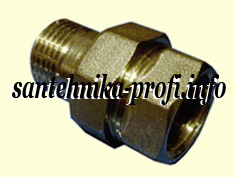

![]()
A new pipe from the ceiling to the upper horizontal radiator layer must be attached to the wall at three to four points. If, however, the old vertical upper steel pipe for the most part is preserved, then it is necessary to securely attach it to the wall with one detachable metal clamp on a hairpin, at the lower point.


Before installing the mounting hooks in the wall, you need to make a marking, for which a new radiator is tried on, if possible, in the exact installation position.
* There may be many options for horizontal displacement relative to the window in the presence of free space. For example, in the center of the window or depending on the location of the furniture next to it. A good option would also be to install a radiator under the opening flap to create a thermal curtain in the path of cold air.
As for heights installation, then it (as a rule) is attached either to the height of the horizontal outlets of the riser (in the case of their fixed position), or to the height of the windowsill. For example, when the opening height from the floor to the bottom of the window sill is 80 cm, a standard radiator (50 cm between the centers of the threaded outlets) can be installed both at the same distance between them and with some shift down or up, there is no fundamental difference in this case.
Never install a heating radiator (water or electric) too high (when installing the appliance on a wall no window this is possible) - this will lead to a sharp decrease in the efficiency of the "battery" and the loss of low and far sections from the heating zone.
Also (except in hopeless situations) do not install the radiator too low (below 10cm from the floor level). This interferes with the normal air circulation, plus contributes to increased dusting of the heat-dissipating fins of the sections.
You mark with a pencil on the wall the installation position of the heater, - the height of the upper plane, the center of the upper thread, the marks of the intersection grooves in which the installation of fasteners is planned (installation of fasteners is required at the extreme sections).
Measure the distance of the offset of the installation point of the support hook (by measuring against the radiator) down from the center of the upper threaded outlet (or from the upper plane of the product) and put the installation marks for the upper row of fasteners on the wall, then mark the bottom row (using a tape measure and plumb).
* Before driving the top row of hooks, be sure to try them on a new radiator (on the side of the end section). On some radiator models, the bend of the heat sinks and the distance between them does not allow the use of such fasteners without modification. Bending or cropping and turning of hooks may be required.
It should also be noted that even if the hook “fits” between the plates, this may not be enough. It is necessary to ensure that the radiator can be removed from it without changing its tilt, in a strictly vertical position (especially important for the top row of fasteners).


Otherwise, the "battery" when hanging (or removing to adjust the fasteners) will wedge between the upper and lower rows of hooks. And this will lead to damage to the enamel between the plates of the heat sinks and greatly complicate the alignment of the product.
It is possible that in this case the radiator cannot be installed at all without additional improvements to the fasteners.
First of all, two hooks of the upper row are installed at the extreme sections of the radiator (left and right). The main installation adjustment (exact height, distance from the wall, horizontalness of the upper edge of the heater, parallel to the cut of the window sill) is performed precisely on them. The upper intermediate hooks are displayed in one line along the cord between them, and then the bottom row is installed.
The distance between the upper and lower rows (at the points of contact with the radiator) may slightly differ from the axial distance, therefore, when installing the fasteners, a slightly lower value should be kept (for a standard aluminum or bimetallic radiator with an axial distance of 50 cm - 50 cm minus 2 - 3 mm ), the error detected during fitting is eliminated by bending the support hooks of the lower row.
Only after checking the position of the heater with a plumb line and horizontal level (as well as the complete absence of play at the reference points) can the radiator be considered fully fixed.
After connecting the pipelines, it is recommended to coat with a thin layer of sanitary silicone (white or transparent) the contact points of the supporting hooks with the radiator.
If, however, you cannot completely exclude the possibility of bias loads on the radiator during operation (for example, in a children's room), then this may not be enough. It is necessary to close the device and all connections with a protective screen, in extreme cases, simply perform additional fixation of the reverse side of the "battery" relative to the wall at several points using the mounting foam (until it completely hardens, only on a cold radiator!).
Now we will consider the methods for the most efficient connection of the device during installation, i.e. without serious violations, we achieve maximum heat transfer from the radiator.
Fig. 1 shows a schematic diagram of a two-pipe heating system for aboutmA with upper heat distribution (top filling), radiator side connection. And in Figure 2, this is the same system, but with a diagonal connection.
* Top filling means filling in the main pipe for supplying heat to the very top (attic or under the ceiling of the upper floor).
The common pipe through which the cooled coolant from the entire building returns to the boiler room ("return") passes through the basement or under the floor of the first floor.

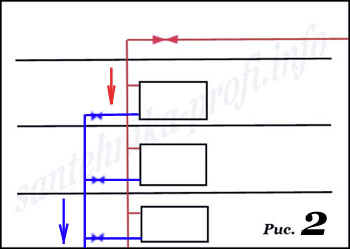
So, - on the diagram №1, the heating devices are connected diagonally, and on the second - on the side.
And now the question is: at what connection will the “battery” heat up better at the same coolant temperature?
We have no doubt that 100 out of 100 people will answer - at the first, diagonal, because it is obvious!
Is it so? Not really. Not everything is so simple here.
And the correct answer is this: at the recommended speed of the coolant in the system (by the way, very small), both schemes will provide almost exactly the same and very high heat transfer characteristics.
If the speed is too low (for example, the duct opening is narrowed), the heat transfer will decrease equally, if the circulation speed is much higher than the recommended one (for example, the circulation pump works in the autonomous system), the ratio can change (but not necessarily towards the diagonal connection, rather the other way around).
Why so, and why will the indicators in each case (at the optimal flow rate) be high? The reason is simple.
Please note that in each figure the heat supply is connected to the upper radiator pipe and the outlet pipe to the lower pipe, and this is very important.
Now in more detail.

The figure shows two (absolutely identical, with the exception of polarity) lateral connection schemes for a large sectional radiator (two-pipe heating system).
As we see, in Figure A). the radiator warms up completely (to the extreme sections), practically over the entire area and its efficiency can reach 95%.
If the heater is connected according to scheme B), then the efficiency (for example, for a radiator of 12 sections) may not reach 40% (in fact, only the first 2 - 3 sections will warm up normally, and the effect of building additional ones will be close to zero) .
So why does the polarity of the connection lead to such completely different results? And there are two reasons.
First, when heated, the coolant (usually water) increases significantly in volume, so even a slight temperature difference leads to a significant change in the weight of the same volume of liquid.
* By the way, it is for this reason that such a device as water level (“water” level, - two transparent vessels with divisions connected by a flexible tube) it is more correct to consider a textbook for physics lessons than a serious measuring tool.
The slightest temperature difference between the vertical sections of the hydraulic level leads to the fact that the device begins to lie shamelessly (and the longer the length of the vertical sections, the greater the error in the mark).
The second - as already noted, the coolant in the central heating system moves at a low (even one can say - a very low speed), despite the very high pressure (usually much higher than the pressure in the water supply network). This is due to the fact that difference pressure between supply and return is minimal (rarely more than 2x - 3x%).
* Far from heat engineering people are inclined to consider the central heating system in some way a hybrid of hot water and sewage. Allegedly, hot water is supplied through one pipe under pressure and flows to another by gravity, and if the first is blocked, then there is no need to shut off the second and you can safely disassemble the pipes.
It is difficult to calculate exactly what percentage of serious accidents in the Russian Housing Fund is accounted for by such a misconception. But what they are and there are many of them is a fact.
When supplying coolant through lower the radiator nozzle hot water in a colder and denser environment immediately pops up and almost all of it immediately goes further through the upper connection (Fig. A).
When serving from above, light hot water “spreads” along the heavier cold layer along the entire length of the heater, and evenly expands into its lower part as it arrives, gradually cooling down.
We believe the essence is clear - in order to achieve maximum heat transfer, it is necessary to supply the coolant to the top of the “battery”.
Unfortunately, in our city apartments, the one-pipe heating system, the lower bottling, is most often found. No, of course from the basement d aboutthe heating pipes go up in pairs (supply and return), but the radiators are connected to both. Those. vertical pipe (riser) filing the heat carrier rises from the basement to the top floor of the building, supplying one heating device on each floor.
Upstream the riser goes into "return" along which the partially cooled coolant goes down again to the basement, on the way feeding the next row of radiators, each of which is usually already in another room, or even in another apartment. The temperature of the last “battery” in such a chain is often close to the temperature of the air in the room.
In Soviet times, when no one saved fuel and there was no way to touch the “batteries” in the apartment, the disadvantages of such a connection were not very noticeable. Moreover, the control valves on the radiators and bypasses were still in working condition (no matter how bad the Soviet ZHEK was with lazy and impudent drunkards - locksmiths, but nevertheless "unlike most modern management companies" with their work "albeit on C grade "but he coped).
Nowadays, work heating system with this connection, residents are usually always unhappy.
Firstly, you won’t surprise anyone right now (in some places he is already considered the norm).
Secondly, serious control over the elements of a common house central heating system, now almost nowhere in the apartments of tenants. Everywhere the inviolability of the home and private property - the owners and tenants arbitrarily "rationalize" the connection scheme of their radiators.
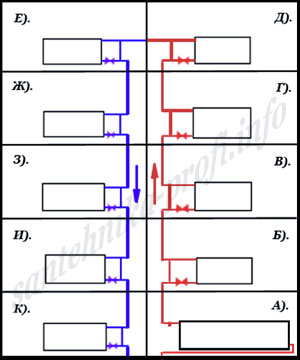 We give an example of such a "rationalization" in one apartment for a one-pipe heating system of a five-story building.
We give an example of such a "rationalization" in one apartment for a one-pipe heating system of a five-story building.
During periods of lack of heat, the owner of the apartment (A) notices that the living conditions have become much cooler than before, and only the first sections normally warm up in the radiator.
And so he cuts out the “bypass”, builds up additional sections and changes the connection scheme to the diagonal one.
As a result, he again has a hot and constantly open window.
* By the way, service organizations, heating system controllers and neighbors should pay attention to this. As a rule, the need for constant additional ventilation day and night is a sure sign of a tenant violating the heat distribution scheme.
The share of the remaining nine apartments (B - K) leaves much less heat than one apartment (A) now consumes.
In principle, it is quite possible to establish and adjust the operation of any heating system (for example, by washer).
But such adjustment should be carried out only by specialists of the service organization with the subsequent sealing of the tuning units excluding the intervention of tenants in the general part of the system (to shut-off valves at the radiator inlet).
And then it makes no difference how he connects his radiator (top, bottom, side or diagonally), it doesn’t matter if it is a five-section radiator or if it grows to fifty sections, nothing bad will happen if the connection is poor with a narrowed duct.
Any deviations from the design, recommended or optimal connection can only damage the tenant - the "rationalizer", but this will not affect the heat supply of the neighbors.
Suppose you live in an apartment building on the top floor with a single-pipe heating system, where the operation of common property is strictly related (in our time this is usually the HOA). If your radiator is the last in the "supply" chain, then the one next to it (at the "return" to the neighbors) will give off much more heat than yours (precisely because the heat carrier approaches it with top branch pipe).
What to do in this case, to arrange an “overlap” with an air vent - automatic?
In no case. Firstly, such an assembly in an open design looks (to put it mildly) somewhat strange, but even if the pipes are sewn into the wall, this can create problems for the service organization during commissioning in the system.
In addition, the feasibility of using an air valve on the radiators is automatic in most cases doubtful.
Of course, it’s very good when some device takes our care upon itself and we can no longer think about it. But let's proceed from real conditions. And the reality is that most of these mechanisms do not differ in compact size and high reliability.
Installation of a standard air vent - automatic machine is unlikely to improve the appearance of the radiator as a whole, rather the other way around (especially since the vast majority of such "automatic machines" more or less reliably work only in the vertical position). In addition, he (as a rule) significantly stands for the "dimensions" of the device and can be accidentally damaged.
Automatic air vents are often very sensitive to coolant contamination - a grain of sand or a speck entering the valve can lead to permanent leakage, and this despite the presence of a protective net (if it is provided for by the construction).
What (with time) the contamination of such a grid can lead to is understandable without explanation. Of course, this problem can be solved by installing an additional filter, but the appearance of such a design will be even worse.
* Air vent - automatic (with a reliable filter) is preferably installed at the highest point of the heating systems of buildings in the presence of a technical floor.
Many manufacturers of aluminum radiators recommend installing it on every heater. In that case, if you forget that it is unacceptable to close it tightly - the gas released was where to go.
* It is for this reason that it is forbidden to bring open fire to the installed air vent - machine. Possible consequences can be much more serious than a break from gas pressure.
Such recommendations (just in case) are similar to the advice to change the rug beyond the threshold to a foam mattress (because if you accidentally stumble, it will fall more gently). In addition, the installation point of the air vent is actually not the highest point of the radiator. Therefore, its protective functions in this case are very doubtful (at 100% coverage). And the radiator that has worked for some time in the heating system is always 100% full, even if this was not the case initially (any free gas is quickly absorbed by the flowing coolant).
The adjusting setting of the air vent - the machine rarely comes in a protected type (at least for a screwdriver) - as a rule it is a cap that unscrews (and twists) very easily. Even a child can do this (after such an “adjustment”, the air vent will most likely stop working in automatic mode, more serious consequences are possible).
Therefore, we prefer not to install such air vents on apartment radiators in general (except in some cases when the “battery” is the top point of the system and is completely hidden behind a protective screen).
It is better to install simple small-sized air vents on open-air radiators (air through them is bleed using an ordinary flat screwdriver or a special key).
1). Small air vent (ø thread 3/4 inch).
2). Small air vent (ø thread 1/2 inch).
3). Automatic air vent (ø thread 1/2 inch).

 For heaters that are at the top of the system, installation of an air vent is mandatory (it should be borne in mind that if the slope of the pipelines along the floors is not performed correctly, then from any standard air vent it will be of little use when starting up - instead, it is better to install a conventional ball valve reliable manufacturer).
For heaters that are at the top of the system, installation of an air vent is mandatory (it should be borne in mind that if the slope of the pipelines along the floors is not performed correctly, then from any standard air vent it will be of little use when starting up - instead, it is better to install a conventional ball valve reliable manufacturer).
If the pipes go higher (through the ceiling) to the neighbors or to the technical floor, it is at your discretion. There is no special need to install an “air vent” here (it can be useful to you only for checking the state of the heating system, i.e. the presence of coolant pressure).
Sometimes the possibility of such a check can be very useful.
Take for example the following case: on the third floor of a typical five-story building, co-workers replaced two old radiators with aluminum ones, and the connection was made with a ø20mm plastic pipe with the greatest possible bend using an internal spring.

 The place of the bend is rigidly fixed, so after some time the transverse cracks of the outer layer of metal plastic went (if you leave everything as it is, it is not far from the accident).
The place of the bend is rigidly fixed, so after some time the transverse cracks of the outer layer of metal plastic went (if you leave everything as it is, it is not far from the accident).
This time the owner invites our specialists and orders a paid shutdown in the service organization. And since the workshop is located in the same building, everything goes quickly, the master reports that everything is turned off - you can safely work.
Our locksmith begins to replace the pipelines of the first radiator - by first opening the air vent to check the shutdown condition. Everything is in order, there is no pressure.
Having finished this work, it proceeds to the next radiator, - the air vent on it is NOT INSTALLED.
The radiator is cold (but the heating season has just ended, so this is not an indicator), so the locksmith informs the owner that it is not possible to check the shutdown state and dismantling in which case is under his responsibility. The owner gives the go-ahead without the slightest doubt, citing the fact that the master of the service organization guaranteed a normal shutdown.
A locksmith starts disassembling, explaining to the owner in the meantime that the disconnection guarantee and the disconnection itself are not the same thing. What a locksmith i the management company could forget to turn it off, but they could turn it off - but not that.
In general, he explains all this and he quietly turns it off, because the first radiator was really turned off, there is no leakage during disassembly (and the responsibility is not on it - you can relax a bit). He does not have time to unscrew the connection to the end, as it is knocked out by pressure and we have a serious accident. Of course, it was quickly eliminated and the neighbors from below were not injured (but recently made repairs, new furniture and the computer system unit doused decently with water).
They called the site master, explained the situation, agreed to meet (the benefit is to go close).
He comes and brings the hanging deputy aboutto with a sawed bow. Say, one of the residents cut down the deputy aboutto and started heating - therefore, an accident, and the management company has nothing to do with it.
What can be an unauthorized start - after all, all radiators are cold? Yes, just try now, prove that the cause of the accident is the mistake of the locksmiths of the service organization (as well as the fact that aboutto the basement, in all likelihood, they just sawed it in the workshop ...).
Now about why in this case until the last moment there was no leakage during disassembly (despite the total pressure in the system).
And the reason is simple a, - the sealing winding by itself always "dangles" on the external thread, but when disassembling it often remains on the internal thread.
It is for this reason, leaks (even drip) may not be observed until the last second.
* Do not make significant efforts when installing a small-sized air vent on a radiator (internal damage is possible - in case of any suspicion, the part should be replaced with such a possibility!).
After bleeding the air, close the screw carefully (until the leak stops and with a slight additional pressure to securely fix it - do not tighten the screw “to the stop” in any case!).
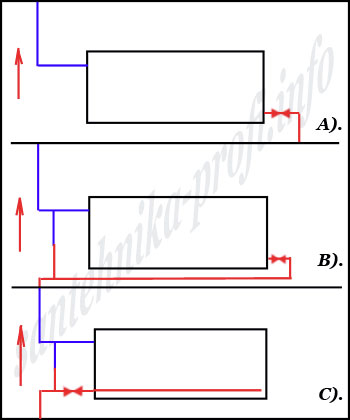 So, how can we “force” the heating radiator to warm up completely, to the extreme sections. A good option for heating systems with a lower (problematic) coolant supply is a diagonal connection (Fig. A). However, such a system looks more or less decent only if the supply and exhaust heat transfer fluids are located on opposite sides of the “battery” and the “bypass” project is not provided.
So, how can we “force” the heating radiator to warm up completely, to the extreme sections. A good option for heating systems with a lower (problematic) coolant supply is a diagonal connection (Fig. A). However, such a system looks more or less decent only if the supply and exhaust heat transfer fluids are located on opposite sides of the “battery” and the “bypass” project is not provided.
And if not? Indeed, in our apartments, the pipes usually pass on the one hand.
Usually in such cases, for diagonal powering the device, the lower pipe is let under the radiator (Fig. B), which certainly clutters the design and in some cases is simply impossible.
But there is another, much more aesthetic way of such installation, this is (Fig. C) internal diagonal connection.
As shown in the figure, from the inlet threads s through the bottom of the radiator (through the radiator nipples i) passes a plastic pipe ø16mm (pipe ø20mm as a rule does not pass anymore and even partial flattening of pipes s doesn't help since nipple i at the joints of the sections are rotated at various angles).
* In order to maintain a normal flow of the coolant inside the MP pipe, inserting anything is unacceptable.
The diagram for clarity shows that the end of the tube does not reach the far point of the radiator (a passage for the coolant is left).
In fact, the metal-plastic pipe should reach the very end and slightly rest against the plug.
The normal duct provides a special preparation of the pipe ends at the inlet and outlet.
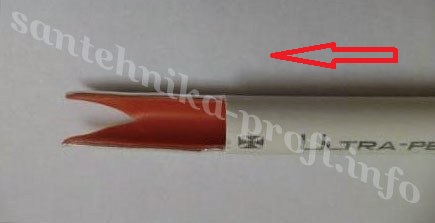
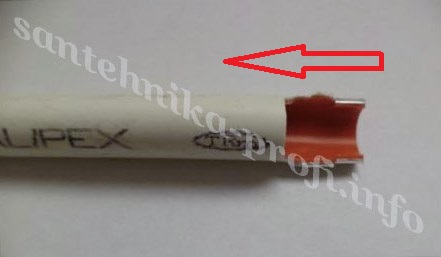
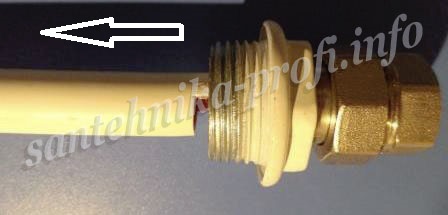 * On the input side, cut out (for example, with scissors for plastic) half the diameter of the pipe to the required length and at the right point is cut with a turn, - to limit the installation depth (after inserting the tip into the plug connection to the limiter, the cutout border should protrude by about 5 mm behind the extreme point of the thread of the foot, see photo).
* On the input side, cut out (for example, with scissors for plastic) half the diameter of the pipe to the required length and at the right point is cut with a turn, - to limit the installation depth (after inserting the tip into the plug connection to the limiter, the cutout border should protrude by about 5 mm behind the extreme point of the thread of the foot, see photo).
At the exit of the pipes s half of the diameter is also cut out (to a length of about 5 cm), while its tip should be shaped like a dovetail (see photo).
On a fully mounted heatsink, both cut-outs should face down.

The heat transfer with this connection is practically no different from the "classic" diagonal (at the same time, such a "modernization" of the radiator is completely invisible).
Do not forget that even the excellent heat transfer characteristics of heating devices can negate the high heat loss of the room.
In conditions of the possibility of an underdrive, it is very important that modern windows and doors (preferably double) are installed in the apartment. A very good option would also be additional insulation of the "street" walls. This device is false walls with insulation (preferably polystyrene or other similar material).
* Insulation of min.vata only with additional vapor barrier! Without sealed briquette packaging, it is allowed to be laid only in internal partitions - for sound insulation, otherwise it will quickly dampen at the border of a cold wall and a warm room.
The device is false - the walls around the window opening also allow you to hide defects capital walls (and as we know, there is no ideal quality of walls in our apartments).
However, often at the same time, a false wall is not built directly behind the "battery", leaving a niche in the structure for it.
Why is this done?
Well, firstly, a radiator in a niche looks (as a rule) much better than on a flat wall. Secondly, for a recessed heater in the wall, the probability of accidental damage is significantly reduced. And the suspension of the "battery" on a solid wall is much more reliable than, for example, on a drywall construction.
And few people take into account that through this small section of the wall the apartment loses much more heat (to “heat the street”) than through the rest of the wall (even without insulation).
But even when the radiator is mounted on a “warm” false wall, a significant percentage of the energy released through it will go through it in the form of infrared (thermal) radiation from the radiator.
* Drywall, plywood and any insulation are more or less permeable to infrared radiation.
However, even when installing the heater in a niche, it is really possible to reduce heat loss many times by pasting a section of the wall with special reflective thermal insulation (see. Photo).
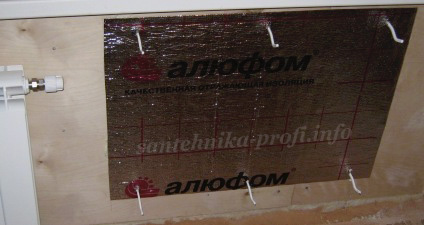
Such insulation is produced (usually) in a roll version and is sold in meters. It is glued to the wall with the reflecting (foil) side to the radiator.
№9
System startup.
If you ordered a shutdown at a service organization, then it is their responsibility to start the system. (no additional charge for this should be charged). But what you should definitely do is to check all the connections for possible leaks (if the radiator was building up - on the section connections, as well as threaded, soldered, and necessarily collapsible connections, carefully review and probe from all sides).
If the highest point of the system site is in your apartment, it will also be better for you to "bleed" the air after applying pressure.
On this, we are closing the topic of "installing radiators."
* Once again, we remind you to turn off the shut-off radiator filled with water by shutting it down both cranes (entry and exit) for a long period is UNACCEPTABLE! Explode.
Pipes are classified by a large number of signs, the main ones are listed below:
- The material from which they are made:
- metal;
- reinforced concrete;
- polymer.
- By production method:
- suture;
- seamless.
- By sectional shape:
- round;
- square;
- rectangular;
- other sectional shapes.
- By appointment and working conditions:
- for high pressure;
- for low pressure.
This simplified diagram minimally shows the large family of this product, as well as its widespread use.
The main task of connecting the pipes is to obtain a seam that will be airtight, durable, reliable. They are divided into two types: detachable and one-piece:
- Detachable connections:
- threaded;
- flanged;
- bell-shaped.
- One-piece connections:
- welding;
- gluing;
- bell-shaped;
- pressing.
Depending on the working conditions, material, geometric dimensions, the best method of connection is determined.
Thread
Threaded connections are one of the oldest. They are used only on round pipes. In the direction of torsion, the right and left threads are distinguished. The second is rarely used, only in special cases.
This type of joint is suitable for water, gas, oil products.
The ends themselves are twisted using additional fittings couplings.
Couplings are ordinary with internal thread on both sides. And also there are combined ones, on the one hand the inside, on the other - the outside.

Threaded connection of steel pipes
Flange connection
A widely used method during the installation of pipelines for various purposes. The connection is made using two flanges welded to two pipes and bolted together.
Also, this option is convenient for connecting to equipment, mechanisms.
Trumpet
It is used for water supply, sewage.
Bonding pipes
This method is used for joining two dissimilar metals.
This method is very convenient where thermal effects are unacceptable.
It is worth noting that more often plastic, rather than metal pipes are glued.
Pressing
A rare way to obtain compounds. Used for copper pipes that work with aggressive environments. Such systems can be seen in refrigeration units.
Welding
The welding connection is the most reliable. It is used to obtain tight joints on large-diameter pipelines designed for gas or oil products.
Detailed description of each method
Threaded
They will be executed in several ways, the most common one is the drive.
The following tools will help you do this job:
- Pipe wrench.
- Coupling with internal thread.
- Seals for sealing. May be: hemp rope, FUM tape or sealant.
- Lock-nut.
Two pipes have an external thread. Apply sealant to them. On one thread length more than on the other. Where there are more turns the nut is screwed up to the end. Then the clutch. Then we wind it to the second part, twisting the campaign with the first. When the coupling stops twisting, we back it with a lock nut. Tighten with keys, carefully, no matter what the clutch bursts.
Flanges
For a flange joint you will need:
- two flanges;
- paronite gasket;
- bolts, washers, nuts;
- keys;
- manual arc welding;
- level.
It is necessary to weld the flanges. Avoid bias, they should be in the same plane.
We catch using the horizontal level. We fasten two bolts into the upper holes. We put the part on the edge of the tube so that the bolts are at the top. We put a level on them and catch the position of the bubble between the strips in the middle. When caught, we do the tack welding at the top point. The horizontal plane is ready.
We rearrange the level, in an upright position, leaning it against the mirror of the flange. We catch the level by slightly adjusting the lower end of the flange which is not yet tacked. Having set the vertical, they set the second tack. And then two more getting four even sections.
Then the welder scalds the flange on both sides. Similarly, manipulations with the second pipe are performed.
After welding, we get two pipes that can be connected. From the bottom we put four bolts into the holes, twist a little. Make a gap, insert the gasket. We insert four more bolts, we twist everything.
Glue
This method is rarely used in metal parts. The process itself does not require much skill from a person, but it takes a very long time.
This work requires:
- glue. BF-2 or 88N or EAF;
- tassel.
Before gluing the parts, first apply the first layer on their surface and allow to dry. This layer will be bonding. Each glue in the instructions says drying time. Then the second layer is smeared and the parts are laid under the press for a day or more. It all depends on the glue.
After cleaning the seam from the glue leak.

Crimp connectors for steel pipes
The welding process is used in almost all joints of metal pipes.
In order to get a seam, welding methods such as:
- gas;
- electric arc;
- contact.
Gas welding is used to obtain one-piece joints in pipes of small diameter with a minimum thickness.
Welded in this way, it can conduct water. The main thing after welding is to test the joints for leaks.
The gas welding post consists of:
- oxygen cylinder;
- acetylene;
- rubber hoses;
- burners.
Resistance welding is of little use. More this method has proven itself in.
The most common way to obtain one-piece joints is electric arc welding, divided into:
- manual
- semi-automatic in the environment of protective gases
In the construction of pipelines, connections are obtained only by welding. An important part is the preparation of the joint for welding.
The pipe must connect to another:
- without fractures and displacements;
- the joint must be cleaned;
- make a chamfer;
- set a gap of 1-3 mm.
Necessary equipment for welding:
- electrodes
- power source (transformer or rectifier);
- cable;
- personal protective equipment of the welder overalls, mittens, brushes.
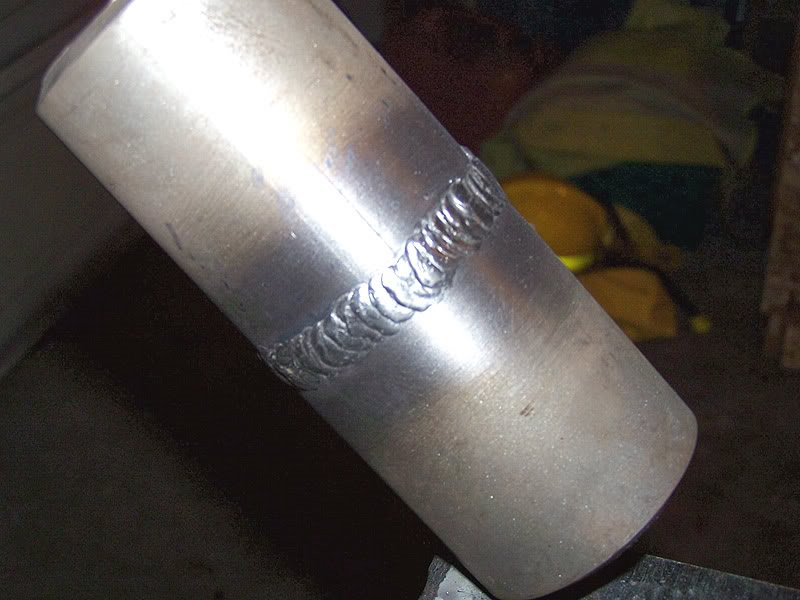
Soldering polyethylene pipes butt and using electrofusion
Trumpet
This type of connection has been widely used in cast iron pipes for the oil and gas industry, housing and communal services. One of the easiest options for permanent joints.
The main process for obtaining a joint is to seal the gap between the bell and the surface of the conical pipe. For this, cement material is used.
First, a return pipe is inserted into the bell and then sealed with a caulking gun, a sealed material. After diluting the cement solution, mint them tightly.
To seal the bell, cement of brand 300-400 is used, which is thoroughly mixed with water in a proportion of nine parts of cement to one part of water. The socket is filled with cement mortar using a scoop and minted with minting until the latter begins to bounce off the cement.
Pressing
This method of obtaining an integral seam has become necessary for compounds of small diameter of non-ferrous metals. Conventional electric arc welding is not capable of welding such metals in its technical parameters, so in this case they found a different approach.
In order to perform welding, you need to insert the prepared end all the way into the fitting. Then treat its surface with a manual or hydraulic press.
To fit such thin-walled non-ferrous metal pipes, press fittings with crimp sleeves are used. They perform crimping in the inner part of the pipe, and the outer seals provide the joint tightness.
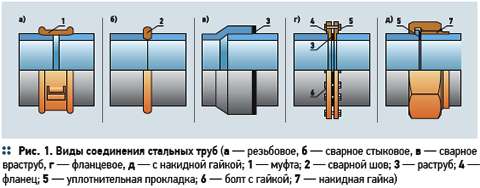
Advantages and disadvantages of each method
Thread
Benefits:
- reliability;
- ease of assembly, the ability to disassemble;
- low cost.
Disadvantages:
- stress in the hollows of the thread, increases the fatigue of the material, reducing its strength;
- the need to use locking means to prevent unscrewing of the working element.
Flanges
Advantages:
simplicity and convenience of reusable connection and disconnection.
Negative properties:
- high complexity in the manufacture, therefore, the price is high;
- with prolonged use, a decrease in its connection, loss of tightness.
Glue
The advantages of this method include its non-laborious process that does not require great skills and efforts.
But the waiting for bonding sometimes reaches three days, which is not always convenient.
This type of connection cannot be attributed to reliable methods.
Benefits:
- reliability;
- durability;
- tightness;
- the ability to connect parts of any shape.
Disadvantages:
- occurrence of residual stresses;
- the ability to change the geometry;
- risk of destruction under vibration and shock loads.
Trumpet
Compared to all types, bell-shaped ones have an advantage in low cost of the possibility of small axial and lateral movements of the pipe, which is very useful for temperature changes and soil shrinkage.
A negative indicator is the difficulty of the connector and the lack of reliability at high pressure.
Pressing
A common positive factor is the excellent self-centering of the mating parts, a stable state under shock loads. Simplicity and not a laborious process.
They are not amenable to reverse disassembly or displacement of each other. Here are a few disadvantages of this method.

Methods of joining metal pipes
Methods of connecting metal pipes with plastic
Areas of use:
- repair, replacement of the old pipeline;
- construction, when installing the gas pipeline use plastic pipesbut in a living room gas should only be in metal pipes.
In such cases, several connection options are used:
- Welding and threaded. In this case, combined couplings are used. Here, one side has a thread, the other a sleeve. The thread connects to the metal end. The other side is with a plastic end. Such adapters are used for small diameters.
- Flanged. For large diameters, flanges are used. In some cases, a metal hose is used.
- When working with cast iron pipes it must be remembered that they are fragile. For minting and pressing use rubber hammers.
- If the installation of the socket joint is carried out outdoors in hot weather, then when the cement is in the gap, it is proposed to lay a damp cloth on it. In order for the cement to crack.
- In gas welding, flammable gas, acetylene, is used. If desired, it can be exchanged for propane, which is cheaper and safer.
- When is the construction of a pipe system for water or gas supply try to weld the swivel joints first, and then when the whole structure is assembled, weld the fixed joint last.
- Do not overtighten the bolts on the flanges. It is possible to break the thread, this applies to threaded connections.
What fittings are needed to connect a heating radiator made of cast iron or aluminum? Do I need to equip the heater with any shut-off or control valves? In our article, we will try to give the reader advice on choosing the optimal set of equipment and on its installation.
Driving and American
What it is
Let's start with a short digression into history.
More recently, by historical standards - some twenty-twenty-five years ago - in our country, only three types of heating appliances were massively sold and used:
- Convectors representing steel plates pressed onto it to increase heat transfer.

We’ll clarify: optionally, a decorative screen and blinds for adjusting heat transfer could be present in their design.
- Plate radiators - two stamped steel plates welded along the perimeter. The coolant moved through the maze of grooves between them.
- Cast-iron sectional radiators. They, it seems, do not need to be introduced, since they are now installed in most apartments.
The mounting method provided for only two:
- Welding. Welded exclusively to the convector hoses: their mechanical strength and service life, at least not inferior to the duration of operation of risers and hoses, did not involve dismantling for repair or replacement.
- Driving. The coupling (in the case of a convector or plate device) or the radiator plug (in the case of a sectional radiator) was driven by a long thread on the eyeliner, simultaneously turning on or screwing on the thread of the device. Then the connection was sealed with a wound locknut.
The first aluminum radiators were mounted the old fashioned way - on the drives. However, after a few years, unpretentious fittings - the Americans, massively distributed including detachable connections with a union nut and a rubber seal. Their main advantage was the simple and quick dismantling of the device: the operation, which previously took up to half an hour, now took no more than a minute and did not require much effort.

Reference: a cast-iron radiator plug from a new radiator can be twisted with a gas wrench number 2.
To cope with the old stuck plug, you have to lengthen it with a lever or use the key number 4.
At the same time, the cork is often not twisted, but in the literal sense of the word breaks in half, losing the thread.
Does the American have flaws? In fact, there is only one drawback: the strength of the connection is limited by the quality of the rubber seal and the density of its clamp. With a high pressure in the circuit (for example, with a water hammer), it is the sealant and the relatively thin union nut of the American that are the weak link.
- In central heating systems with a high probability of exceeding the nominal pressure characteristic of them, it is better to use the usual threaded runs.

- American is desirable to use in autonomous systems.
Fittings Set
Now let's find out what a set of fittings for radiators will be in both cases.
Connecting on races
For the classic side connection in an apartment building, the radiator is equipped with the following set:
On the upper floors of houses with lower bottling, the equipment is complemented by a Mayevsky crane, which is installed in the top blank plug bore under it. The sizes of fittings for radiators are determined by the diameter of the hoses; As a rule, it corresponds to DN20 (3/4 inch). Bends (long threads) are usually cut directly on the eyeliner.
Useful: the best threaded fittings for cast iron radiators are traditionally made from the same cast iron.
Radiator plugs for cast-iron radiators made of steel or brass on sale, in general, can not be found; brass locknuts are too fragile, and steel locks tighten over time with steel overhang and cannot be disassembled.

American Connection
In this case, the only fittings for connecting heating radiators are the Americans themselves in the amount of two pieces. One of their threads is screwed into the radiator plug through passage, the second into the coupling or element of shut-off and control valves.
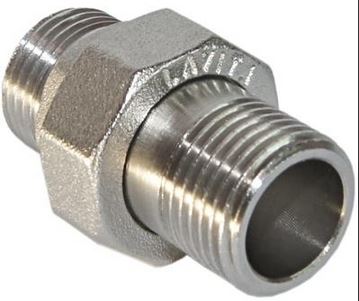
To connect the faucet in the radiator plug, American women are used with Dad-Dad threads.
When installing heating yourself, it is useful to know a few subtleties.
- With a large number of radiator sections, it is preferable not to have a lateral connection, but diagonal or from bottom to bottom. In this case, to connect to the fitting you will need one plug with the right thread and one with the left.
- The diameter of the threads in the plugs of aluminum and bimetallic radiators in most cases is 1/2 inch (DN15). However, if the number of sections is more than 10, it is desirable to use eyeliners of size DN20.
- Americans often complete the already mentioned elements of shut-off and control valves. The taps and chokes combined with the fittings are more compact than the two products separately, and their price is often lower than the total cost of the fitting and the tap.

Mounting
Driving
Here is the instruction for connecting a cast iron battery for drives.
- We drive on the long threads of the eyeliner until the lock nut and the plug through passage.
- We mount the radiator, making the threads of the eyeliner in the first section by 1-3 centimeters.
Please note: the heater is hung out horizontally, level.
With a bias towards the eyeliner, air will collect in it.
- We wind the plug on the thread with a bunch of sanitary flax with paint or.
- We wrap it in a radiator until it stops with moderate effort.
- We drive the locknut to the cork, leaving a gap of 5 to 10 mm between them.
- We wrap a bundle of flax in the remaining clearance along the thread (again with paint or sealant).
- Tighten the locknut.
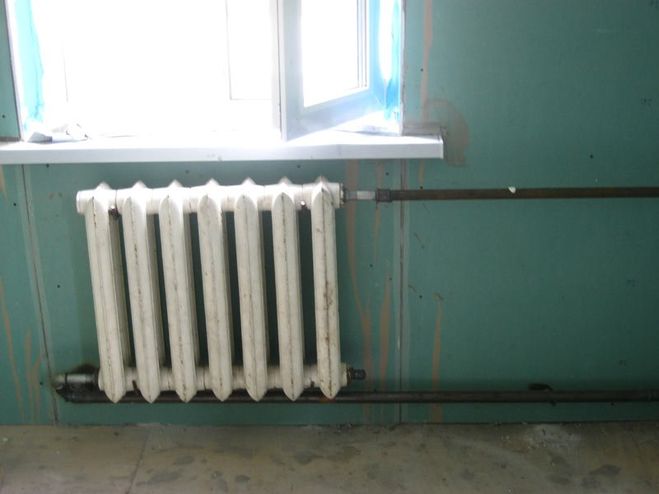
American
The procedure here is noticeably simpler:
- We disassemble the Americans;
- We screw the parts of the fittings with the union nut into the coupling, tap or throttle, and the elements with the gasket into the radiator plugs. For winding, we use the same linen with paint or a polymer thread - sealant.
- We mount the radiator on the brackets.
- We screw the union nuts of the American women by hand and carefully, without unnecessary efforts, we tighten them with an open-end wrench or adjustable wrench.

Fittings
What reinforcement elements can be used in the radiator harness?
An important point: bypass must be present in front of the throttling and locking devices in any heating system.
Otherwise, the valves and throttles will regulate the throughput of the entire circuit.

Conclusion
Of course, this material does not claim to be the ultimate truth; which connection method is better to choose is up to the reader to decide. Additional information for consideration will be provided to him by the video in this article. Good luck!

